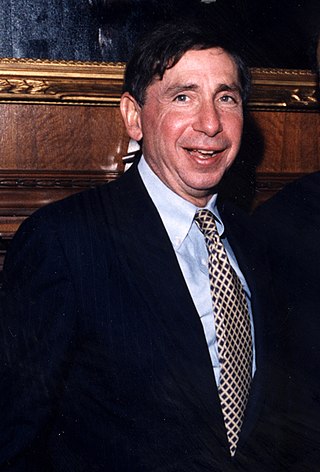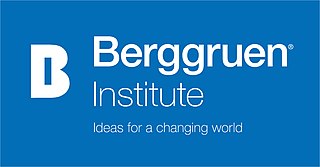
Walter Hubert Annenberg was an American businessman, investor, philanthropist, and diplomat. Annenberg owned and operated Triangle Publications, which included ownership of The Philadelphia Inquirer, TV Guide, the Daily Racing Form and Seventeen magazine. He was appointed by President Richard Nixon as United States Ambassador to the United Kingdom, where he served from 1969 to 1974.

The Solomon R. Guggenheim Museum, often referred to as The Guggenheim, is an art museum at 1071 Fifth Avenue between 88th and 89th Streets on the Upper East Side of Manhattan in New York City. It is the permanent home of a continuously expanding collection of Impressionist, Post-Impressionist, early Modern, and contemporary art and also features special exhibitions throughout the year. It was established by the Solomon R. Guggenheim Foundation in 1939 as the Museum of Non-Objective Painting, under the guidance of its first director, Hilla von Rebay. The museum adopted its current name in 1952, three years after the death of its founder Solomon R. Guggenheim.

The American Museum of Natural History (AMNH) is a natural history museum on the Upper West Side of Manhattan in New York City. Located in Theodore Roosevelt Park, across the street from Central Park, the museum complex comprises 20 interconnected buildings housing 45 permanent exhibition halls, in addition to a planetarium and a library. The museum collections contain about 35 million specimens of plants, animals, fungi, fossils, minerals, rocks, meteorites, human remains, and human cultural artifacts, as well as specialized collections for frozen tissue and genomic and astrophysical data, of which only a small fraction can be displayed at any given time. The museum occupies more than 2,500,000 sq ft (232,258 m2). AMNH has a full-time scientific staff of 225, sponsors over 120 special field expeditions each year, and averages about five million visits annually.

The Brooklyn Museum is an art museum located in the New York City borough of Brooklyn. At 560,000 square feet (52,000 m2), the museum is New York City's second largest and contains an art collection with around 500,000 objects. Located near the Prospect Heights, Crown Heights, Flatbush, and Park Slope neighborhoods of Brooklyn, the museum's Beaux-Arts building was designed by McKim, Mead & White.

Michael Kantor is an American attorney who served as the United States Trade Representative from 1993 to 1996 and United States Secretary of Commerce in 1996 and 1997.

Robert Kenneth Kraft is an American sports executive and businessman. He is the chairman and chief executive officer (CEO) of the Kraft Group, a diversified holding company with assets in paper and packaging, sports and entertainment, real estate development, and a private equity portfolio. Since 1994, he has owned the New England Patriots of National Football League (NFL). Kraft also owns the New England Revolution of Major League Soccer (MLS), which he founded in 1996, and the esport-based Boston Uprising, which he founded in 2017. He has an estimated net worth of $11.1 billion dollars according to Forbes.
Theodore Ryland Sizer was a leader of educational reform in the United States, the founder of the Essential school movement and was known for challenging longstanding practices and assumptions about the functioning of American secondary schools. Beginning in the late 1970s, he had worked with hundreds of high schools, studying the development and design of the American educational system, leading to his major work Horace's Compromise in 1984. In the same year, he founded the Coalition of Essential Schools based on the principles espoused in Horace's Compromise.

The Hall of Fame for Great Americans is an outdoor sculpture gallery located on the grounds of Bronx Community College (BCC) in the Bronx, New York City. It was the first such hall of fame in the United States. Built in 1901 as part of the University Heights campus of New York University (NYU), the structure was designed by architect Stanford White to conceal a retaining wall for the Gould Memorial Library. The hall commemorates 102 prominent Americans, selected by a board of electors and grouped into one of fifteen categories. The physical structure consists of a loggia with colonnades measuring 630 feet (190 m) long. The colonnades contain niches with plaques and 96 bronze portrait busts.
The Annenberg Foundation is a family foundation that provides funding and support to non-profit organizations in the United States and around the world. Some of the Foundation's core initiatives are the Annenberg/Corporation for Public Broadcasting (CPB) project, which funds many educational television shows broadcast on Public Broadcasting Service (PBS) public television in the United States as well as The Annenberg Community Beach House, The Annenberg Space for Photography, Metabolic Studio, explore.org, Wallis Annenberg PetSpace and the Wallis Annenberg Center for Performing Arts.
The Chicago Annenberg Challenge (CAC) was a Chicago public school reform project from 1995 to 2001 that worked with half of Chicago's public schools and was funded by a $49.2 million, 2-to-1 matching challenge grant over five years from the Annenberg Foundation. The grant was contingent on being matched by $49.2 million in private donations and $49.2 million in public money. The Chicago Annenberg Challenge was one of 18 locally designed Annenberg Challenge project sites that received $387 million over five years as part of Walter Annenberg's gift of $500 million over five years to support public school reform. The Chicago Annenberg Challenge helped create a successor organization, the Chicago Public Education Fund (CPEF), committing $2 million in June 1998 as the first donor to Chicago's first community foundation for education.

NYU Langone Health is an academic medical center located in New York City, New York, United States. The organization consists of the NYU Grossman School of Medicine and NYU Grossman Long Island School of Medicine, both part of New York University (NYU), and more than 300 locations throughout the New York metropolitan area, including six inpatient facilities: Tisch Hospital; Kimmel Pavilion; NYU Langone Orthopedic Hospital; Hassenfeld Children's Hospital; NYU Langone Hospital – Brooklyn; and NYU Langone Hospital – Long Island. It is also home to Rusk Rehabilitation. NYU Langone Health is one of the largest healthcare systems in the Northeast, with more than 46,000 employees.

Christina Hull Paxson is an American economist and public health expert serving as the 19th president of Brown University. Previously, she was the Hughes Rogers Professor of Economics & Public Affairs at Princeton University as well as the dean of Princeton School of Public and International Affairs.

The Felix M. Warburg House is a mansion located on 1109 Fifth Avenue and 92nd Street on the Upper East Side of Manhattan in New York City. The house was built from 1907 to 1908 for the German-American Jewish financier Felix M. Warburg and his family. After Warburg's death in 1937, his widow sold the mansion to a real estate developer. When plans to replace the mansion with luxury apartments fell through, the Warburgs donated it in 1944 to the Jewish Theological Seminary of America. In 1947, the Seminary opened the Jewish Museum of New York in the mansion. The house was named a New York City designated landmark in 1981 and was added to the National Register of Historic Places in 1982.

The Berggruen Institute is a Los Angeles-based think tank founded by Nicolas Berggruen.

Nikole Sheri Hannah-Jones is an American investigative journalist, known for her coverage of civil rights in the United States. She joined The New York Times as a staff writer in April 2015, was awarded a MacArthur Fellowship in 2017, and won the Pulitzer Prize for Commentary in 2020 for her work on The 1619 Project. Hannah-Jones is the inaugural Knight Chair in Race and Journalism at the Howard University School of Communications, where she also founded the Center for Journalism and Democracy.
The Simons Foundation is an American private foundation established in 1994 by Marilyn and Jim Simons with offices in New York City. As one of the largest charitable organizations in the United States with assets of over $5 billion in 2022, the foundation's mission is to advance the frontiers of research in mathematics and the basic sciences. The foundation supports science by making grants to individual researchers and their projects.

Susanna Loeb is an American education economist and director of the Annenberg Institute at Brown University. She was previously the Barnett Family Professor of Education at the Stanford Graduate School of Education, where she also served as founding director of the Center for Education Policy Analysis (CEPA). Moreover, she directs Policy Analysis for California Education (PACE). Her research interests include the economics of education and the relationship between schools and educational policies, in particular school finance and teacher labor markets.

Brown University is well known for its undergraduate Open Curriculum, which allows students to study without any course requirements outside of their chosen concentration (major). To graduate from Brown's College, students need only have taken 30 courses, completed a concentration, and demonstrated fluency in the writing of English. Adopted in 1969 after the circulation of a report by Brown undergraduate students Ira C. Magaziner and Elliott E. Maxwell. The open curriculum distinguishes Brown from peer schools—particularly those with core curricula, like Columbia University and the University of Chicago—and has become one of the university's best-known attributes.














